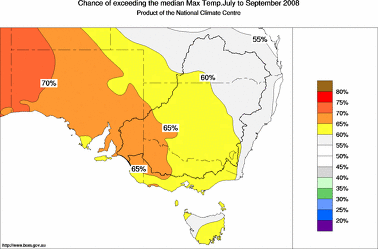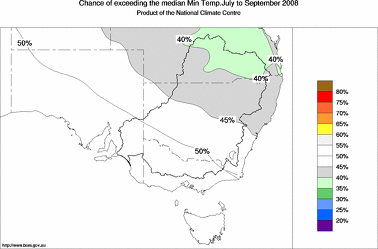|
The pattern of seasonal maximum temperature odds across southeastern Australia
is a result of the combined effects of above average temperatures
in the Indian Ocean surrounding the west coast of WA, and a
warming trend in the Pacific. The Indian Ocean signal dominates the
outlook.
Averaged over July to September, the chances are between 60 and 70% for above
normal maximum temperatures over South Australia, Victoria and in New South
Wales west of a line from the ACT to near Bourke (see map). So for every ten
years with ocean patterns like the current, about six or seven July to
September periods are expected to be warmer than average over these parts of
southeastern Australia, with about three or four being cooler.
Over the rest of the region, in New South Wales east of a line joining the ACT
and Bourke, and the whole of Tasmania, the outlook for seasonal maximum temperatures
is close to neutral (55-60%). So in the years when ocean temperature patterns were similar
to those currently observed, warmer-than-normal daytime July to September temperatures
occured about as often as colder-than-average temperatures.
Outlook confidence is related to how consistently the Pacific and Indian
Oceans affect Australian temperatures. During July to September, history shows this
effect on maximum temperatures to be moderately consistent
over northern SA, northern and eastern NSW and northern Tasmania. However, elsewhere
it is only weakly consistent (see background information).
The outlook for seasonal minimum temperatures indicates close to neutral
conditions with odds in the 40 to 55% range throughout the southeast region
(see map). So the chances of being warmer than average are similar to the
chances of being cooler. This means for every ten years with ocean patterns
like the current, night-time temperatures in about five July to September
periods are expected to be warmer than average and about five are expected
to be cooler than average.
History shows the oceans' effect on minimum temperatures in the July to September
period to be moderately consistent over parts of northern and eastern New South
Wales. However, over western NSW, most of South Australia, Victoria and Tasmania,
the influence is only weakly or very weakly consistent, so this outlook needs to
be used with caution in these areas.
| 










